

Canon EOS 5D MkIII Hands-on Review
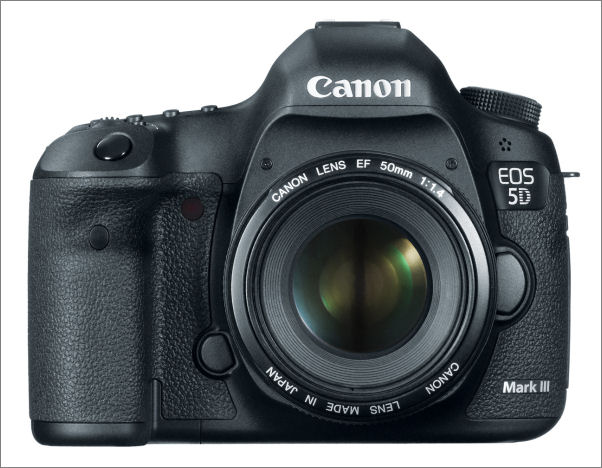
The Canon EOS 5D MkIII is an upgrade of, but not a replacement for, the Canon EOS 5D MkII. While the MkIII is the more advanced camera, the MkII has been retained as a lower price alternative (~$2100 for the MkII vs. ~$3450 for the MkIII).
So exactly what does the 5D MkIII offer over the 5D MkII That makes it worth and extra $1300 or so? Well, the major new features include:
- A completely new 61 point AF system with 41 cross sensors (which is the same AF sensor used in Canon's flagship EOS 1D X) with AF to -2EV
- A new 22.3MP CMOS sensor with a gapless microlens, 8 channel readout and lower noise
- A 63 Zone iFCL metering (same as EOS 7D) which includes both color and focus information to determine exposure
- A new Digic 5+ processor (17x faster than the EOS 5D MkII's Digic 4) which enables faster operation and more extensive real time in-camera processing of images.
- Native ISO settings of 100-25600 with expansion to 50-102400
- 6fps continuous shooting with unlimited JPEG shooting when the fastest CF memory cards are used.
- Enhanced video capability including audio monitoring, embedded time codes and selectable compression schemes.
- In-camera HDR. 3 images taken at +/- 3 stop intervals with in-camera image alignment
The high speed processing is also required to deal with all the data provided by the new and more complex 61 zone AF system, as well as to read out the status of all 61 AF zones for the iFCL metering, which not only reads 35 exposure zones but also uses the AF information and color data to more accurately calculate exposure.
Operation and Handling
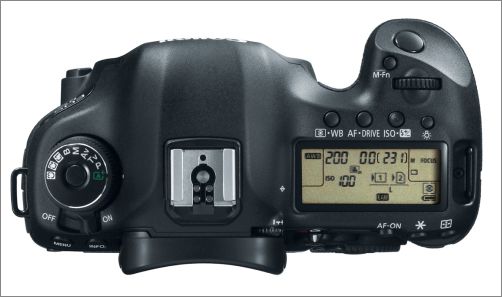
The basic control layout of the Canon EOS 5D MkIII is closer to that of the Canon EOS 7D than the 5D MkII. The on/off switch is now located just below the mode selection dial on the top left of the camera. Similarly the 5D MkIII and 7D both have a dedicated switch (located just to the right of the viewfinder eyepiece) which selects either Live View or Video mode and in the center of this switch the button either stats and stops Live view mode or starts and stops Video mode.
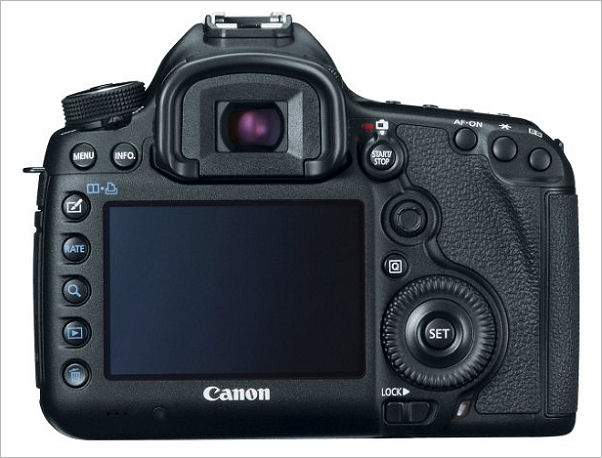
The EOS 5D MkIII has the usual EOS QCD (quick control dial) which operates in the same way as the QCD on most other EOS bodies. However in video mode the QCD becomes touch sensitive which allows silent control of shooting parameters while recording video.
The menu system of the EOS 5D MkIII is based on that of Canon's flagship EOS 1D X. Compared to the 5D MkII it gains a considerable number of functions related to the much more complex AF system, including (adjustable) presets for various situations such as subjects that move erratically or subjects that are likely to accelerate and decelerate smoothly.
Auto ISO is available and both maximum and minimum can be set by the users. It's also possible to set a minimum shutter speed for auto mode, within the range of 1s to 1/250s.
The LCD is slightly larger than that of the 5D MkII (3.2" vs 3") and has a slightly higher dot count (1,040,000 vs 920,000). The viewfinder coverage of the 5D MkIII is now 100% (the 5D MkII was only 98%).
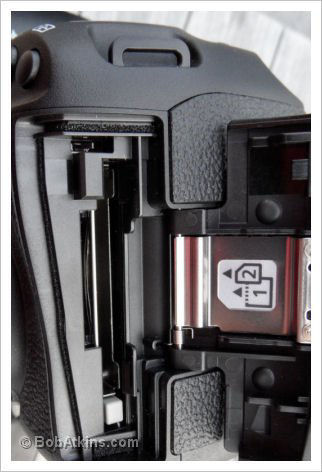
The EOS 5D MkIII accepts both CF and SD(HC/DX) memory cards and supports UDMA 7. Images can be written to either card or to both cards and the camera can switch from one card to the other when the first card is full. With the fastest UDMA 7 CF cards the JPEG buffer size is essentially unlimited when shooting at 6fps. Canon claim you can take 16270 JPEGs before the buffer fills, but I will admit that I didn't test that claim! Shooting RAW you can get around 17 or 18 shots before the buffer slows things down to around 2.5fps. Shooting RAW + large/fine JPEGs the buffer holds around 7 shots and after that the frame rate falls to around 2fps. With slower, non-UDMA cards buffer size will be somewhat smaller (much smaller for JPEGs).
The EOS 5D MkIII feels very solid and fits the hand well (at least my hand). At a little over 2lbs it's certainly not a lightweight camera, though it is significantly lighter than the 1D series cameras (e.g. the EOS 1D X weighs close to 3lbs). The operation feels "crisper" than that of the 5D MkII due to the increased processor speed and faster shutter and mirror operation (6fps vs 3.9fps). This means that the viewfinder blackout time is 112ms on the 5D MkIII vs. 149ms on the 5D MkII. Shutter lag on the 5D MkIII is 59ms vs. 73ms for the 5D MkII.
Autofocus
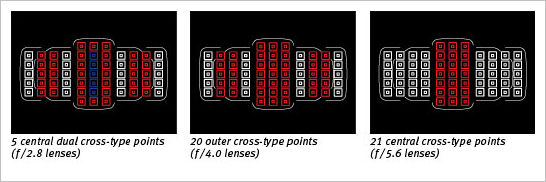
Perhaps the most obvious difference between the 5D MkII and the 5D MkIII when you pick it up and look through the viewfinder is that the old 9 point AF system (inherited from the original EOS 5D and ultimately from the EOS 20D) has been replaced by the brand new 61 point AF system which was developed for the flagship EOS 1D X body. The illustration above shows some details of the new system. There are multiple cross sensors, with high precision sensors for faster lenses. The physical details of the sensor show that while discrete AF points are displayed, the sensors themselves are continuous linear sensors arranged in such a way as to give better "out of focus" indication. That means lenses know where they are even when well out of focus and the camera can drive them rapidly to the correct focus point without having to first test which way to move. That eliminates focus "hunting". The AF system of the EOS 5D MkIII is rated down to -2EV.
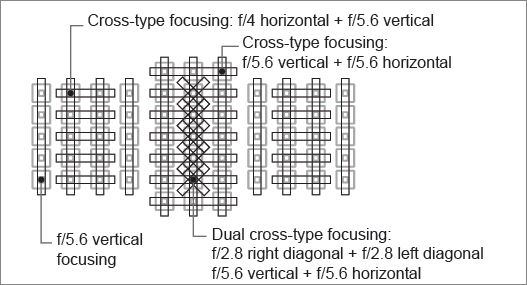
The AF zones can be used in a variety of ways and configurations from a small AF spot in the center, to the camera choosing from all 61 points automatically. They can also be grouped such that there is a particular AF zone which is primary, but if focus cannot to found in that zone the 8 surrounding zones activate and are used for focusing.
There are also preset AF options designed for specific focus tracking environments. For example there's a setting optimized for subjects which may move erratically, a setting optimized for subjects which may accelerate or decelerate etc.
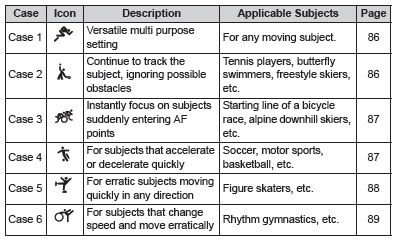
Not all lenses can use all the AF zones at their maximum precision, though most of the fast "L" series lenses can, and most lenses can use most of the AF system capability.
For example, the group A lenses can AF with all 61 AF zones, all 33 cross sensors and all 5 cross and diagonal sensitive sensors. These lenses are basically the fast (f2.8 and faster) primes and zooms
The group B lenses can also use all 61 AF zones, 40 cross sensors but only the very center AF zone is capable of both cross and diagonal high precision AF. The group B lenses are the ultrawide primes (14/2.8, 20/2.8, 24/2.8, 24-70/2.8 and 15/2.8 fisheye).
The group C lenses also can AF with all 61 zones and 41 cross sensors but none can access the diagonal component of the center zone AF sensor, even if they are faster than f2.8. Most of the long f4 telephoto lenses are in this group, though the 50 and 100mm macro lenses are in it too.
The list goes on down to group H lenses which can only use the single central AF zone. However the only lens in this group is the 35-105/4-5.6 in both the USM and non-USM versions. There's no way to predict exactly which group any given lens will fall into from either age, focal length or speed. You have to check the list which is found in the user manual (pages 78-84).
Though Canon only list which Canon lenses fall into the various groups, it appears that most of the more commonly used 3rd party lenses probably fall into group C, which isn't bad. The C lenses can use all 61 AF zones and 41 of those zones act as cross type sensors
Why different lenses can use different sensor capabilities is complex, but it pretty much comes down to the size of the lenses' exit pupil and its distance from the focal plane. This varies from lens to lens. In turn this affects the pattern of light hitting the phase sensitive AF sensor and means that for some lenses some AF zones won't receive enough light, despite having the same maximum aperture as other lenses which do provide enough light. All this is a result of the new AF system being designed to give the best possible AF performance with all lenses, rather than a system that gave the same (but lower) performance with every lens.
Like the 5D MkII, the 5D MkIII will only AF with lenses which are f5.6 or faster, so you don't get AF with an f5.6 lens used with a Canon 1.4x TC or an f4 lens with a Canon 2x TC. It's the latter case that may be of most concern, since it excludes AF when a 2x TC is used with lenses such as the 300/4L IS USM, 400/4DO IS USM, 500/4L IS USM, 600/4L IS USM. This restriction is also present in the EOS 1D X, but earlier 1D and 1Ds cameras could AF with lenses having a maximum aperture of f8. Canon have stated that the choice was either better AF at f5.6 and faster or AF all the way to f8 - but not both. It's probably true that most photographers would prefer better AF with lenses of f5.6 and faster.
Canon provide a number of Not that a difference between the EOS 5D MkIII and the EOS 1D-X is that the 5D MkIII does not have the EOS iTR (Intelligent Tracking and Recognition) AF mode of the EOS 1D-X which recognizes the subject based on face and color detection from the AE system, and tracks it using AF points. The EOS 1D-X has separate processors dedicated to the AF System which allows this more complex and computationally intensive function.
In practice I found the new AF system of the EOS 5D MkIII to be accurate and reliable, even on moving subjects. I can't provide any numbers, but it certainly seemed to be faster then the 5D MkII, with a greater percentage of sharp images of moving subjects.
Exposure
The new iFCL metering system of the EOS 5D MkIII seems to be pretty reliable. After shooting maybe 400 images I found that the vast majority were well exposed. If anything the exposure tends to be biased a little towards underexposure and on a low contrast scene the tendency is for "exposure towards the middle" rather then "exposure to the right", but it's always better to slightly underexpose than to overexpose. Once a highlight is burned out it's gone forever, while shadow detail can usually be recovered if slightly underexposed.
The EOS 5D MkIII has a very wide range of exposure compensation, from +5EV to -5EV and extensive bracketing capability with up to 7 exposures at up to 3EV intervals.
In addition the EOS 5D MkIII can do in-camera multiple exposures. Up to 9 exposures can be combined in-camera via one of several combination modes. Additive combination is just like multiple exposures on film where the brightness of one image adds to the image it's combined with. If normal exposure is used for all images, the final image will be overexposed. Average is what it sounds like, the images are added and then the brightness divided by the number of images added. In this case if normal exposure is used, the final composite image will also show normal exposure. In Bright mode only bright objects in each original picture are composited together. If bright objects do overlap, their brightness doesn't increase, as it would in the Additive setting. Finally in Dark mode the darker parts of each scene are combined together, and bright parts are suppressed or ignored. If bright areas overlap, their brightness does not increase. You can choose whether to save all the images or only the final composite image. You can also choose whether to composite JPEGs (in which case the result is a JPEG) or RAW files (in which the result is a composite RAW file).
Image Quality
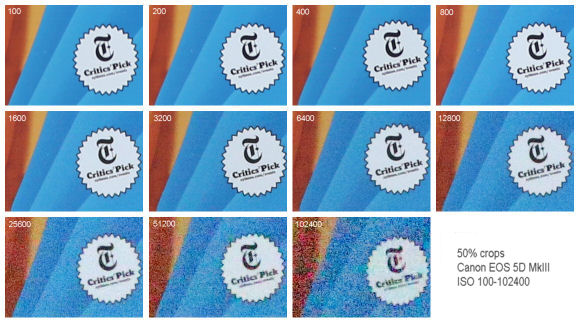
See Larger Image
Comparing JPEGs shot at standard default settings from the EOS 5D MkIII with those from the EOS 5D MkII it's evident that the MkIII shows lower noise levels at high ISO settings. The difference seems to be close to the 2 stops that Canon have claimed. However, looking closely at the images it appears that the cleaner appearance of the MkIII images is obtained though better (or more aggressive) noise reduction. When RAW images are compared the noise levels are much closer. The MkIII still shows a little lower noise, but the difference is probably more like 1/2 stop than 2 stops.
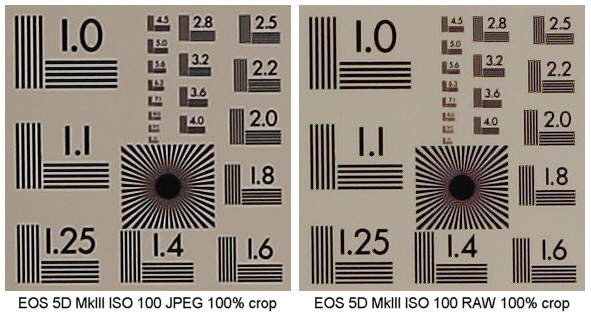
LEFT: JPEG produced in the camera. RIGHT: JPEG produced from RAW file converted in Canon's DPP software
Close examination of the JPEG images and comparison with optimally processed RAW images in DPP also shows that the JPEGs have lost some detail and show sharpening artifacts (such as slight bright outlines on hard edges). Even at low ISO settings, optimally processed RAW images show quite a bit more sharpness than JPEGs do, even when JPEG noise reduction is set to "off" (though it's never really off).
As you would expect from the similar pixel pitch of the 5D MkIII and 5D MkII sensors, there's virtually no difference in resolution for optimally processed RAW images from the two cameras.
Video
The EOS 5D MkII established itself as the "low cost" camera for professional video cinematography and was used in the shooting of several feature films (including "Act of Valor", as well as many in dependant films and shorts. The EOS 5D MkII was also used for shooting many TV programs such as an entire episode of "House", a number of BBC TV programs and opening sequences for "Saturday Night Live". The EOS 5D MkIII builds on that reputation, adding a number of features videographers asked for including an audio monitoring output, on screen display of audio levels, embedded time codes and a choice of video compression systems.
HD video uses the standard H.264 codec, but as with the 1D-X there is a choice between ALL-1 and IPB compression schemes. IPB is Bi-directional compression and basically records differences between frames. It produces the smallest files. ALL-1 is Intra-coded Frame where each frame is individually compressed. While files are 3x larger than IPB compressed files, image quality is higher and less processor power is required for playback. The EOS 5D MkIII also supports the recording of timecodes in video files.
In addition, the higher processor speed (17x that of the 5D MkII processor) allows every pixel to be read from the sensor before conversion to the smaller video format. The 5D MkII had to skip alternate lines, meaning that only 1/2 the sensors pixels could be used. This means that the 5D MkIII produces a slightly higher quality image with lower noise, less moire patterning and less "rolling shutter" problems. The difference isn't huge for some scenes when the ISO is low and moire patterns and rolling shutter issues aren't present because whatever the sensor pixel count, the video format is 1920 x 1080 pixels, but the 5D MkIII video is still a little cleaner, plus it stands up better to post exposure processing.

Still shot during video recording and saved as JPEG
In video mode you can take a still image at any time, but the video will briefly pause. The full sensor output is recorded if saved as a RAW file, but the image will be cropped to the video aspect ratio if the still is saved as a JPEG.
Since the EOS 5D MkIII sensor contains no phase sensitive AF elements (such as are found in the Canon Rebel T4i sensor), there is no continuous tracking AF while shooting video. This is more of concern to amateur than professional videographers since professional video is almost always shot with manual focus control.
HDR
The Canon EOS 5D MkIII offers in-camera HDR (High Dynamic Range). In this mode three shots are taken at three different exposures, then the three images are aligned and a single HDR JPEG is created. The range of exposures can be set to either auto or +/- 1, 2 or 3 stops. The HDR image can be processed with a number of options - natural, art standard, art vivid, art bold and art embossed.
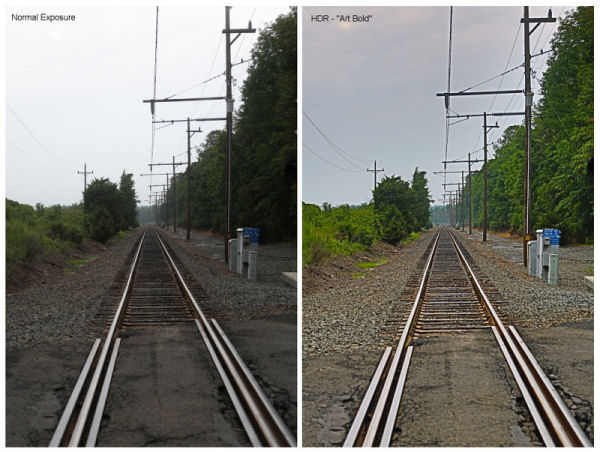
I tested the HDR features and it works quite well, though there certainly isn't the degree of control over the final image that you can get using an external editor. In-camera HDR can be used handheld as long as the slowest of the three exposures still uses a fast enough shutter speed that the image is sharp and you don't move the camera too much between the three exposures. Obviously HDR requires a subject which doesn't move while the three frames are shot. In most situations the use of a tripod is preferred, but it's certainly possible to do hand held HDR images.
The three individual exposures are stored in the format specified in the camera at the time (e.g. JPEG, RAW or JPEG+RAW), but the HDR image is, of course, only stored as a JPEG image.
In camera HDR provides a quick and easy way to evaluate an HDR image, but I suspect anyone serious about HDR will chose to combine images post exposure in an image editor with more options and flexibility. Since the Canon EOS 5D MkIII allows bracketing of up to 7 shots at up to 3EV steps, it should certainly be possible to get better HDR images by bracketing and combining multiple images post-exposure.
Battery Life
Canon specs indicate that the LP-E6 in the EOS 5D MkIII should be good for around 950 shots or about 90 minutes of video (at 23°C) under standard CIPA test conditions. In my tests I found that after shooting 222 shots over the course of about 2 hours, the in-camera battery meter showed 86% of the charge remaining which somewhat better performance than Canon's specs!
Shooting capacity drops by about 10% at low temperatures (0°C). When using Live View the number of shots per charge drops significantly, to around 200 shots at 23°C
Conclusions
The Canon EOS 5D MkIII is certainly a more capable camera then the EOS 5D MkII. Overall operation is faster, AF is better, exposure control is better, it has more advanced video capability and controls along with a number of new features such as in-camera HDR, in-camera correction of chromatic aberration (with compatible EOS lenses), electronic levels and an in-camera image rating function. The 5D MkIII also shows somewhat lower noise than the 5D MkII (especially for JPEGs), a greater ISO range and a faster frame rate.
So the question isn't whether the EOS 5D MkIII is a more advanced and capable camera than the EOS 5D MkII, because it clearly is. The question is whether it's worth an extra $1300 and whether a particular photographer would be likely to need the extra capability it offers.
When it comes to absolute image quality, there's not a huge amount of difference between the EOS 5D MkII and EOS 5D MkIII. The EOS 5D MkIII may have a slight edge, but if you're shooting in RAW and optimizing the image in DPP or similar software, then you really aren't going to see a very noticeable difference. So if the subject doesn't need the advanced AF system of the EOS 5D MkIII or the advanced capabilities of the iFCL exposure system, or you don't need to shoot multiple JPEG images at 6fps and/or you're not a budding cinematographer then a 5D MkII owner may feel no pressing need to upgrade to a 5D MkIII, unless they need or want the extra features such as electronic levels, in-camera HDR etc.
On the other hand if you're a sports or wildlife photographer who often has to deal with moving subjects in variable and difficult lighting conditions, then the EOS 5D MkIII might well be a very worthwhile upgrade from an EOS 5D MkII. Similarly if you are seriously into professional video work, then the improvement in image quality and advanced features of the EOS 5D MkIII (audio monitoring, embedded time codes, choice of compression schemes etc.) may be well worth the extra cost of the 5D MkIII over the 5D MkII.
I only had a few days shooting with the Canon EOS 5D MkIII, but in that time it performed well and, as an experienced Canon EOS user, I found it easy to use with most of the controls in familiar locations. If it has the features that you need, I can certainly recommend it.
Could anything have been better? Well some would like to have seen a sensor that was more revolutionary than evolutionary, with higher resolution and higher dynamic range. However it's also true that for the majority of users, the resolution and dynamic range of the EOS 5D MkIII is perfectly fine and probably higher than they will ever need. Only when compared with a camera like the Nikon D800 does the 5D MkIII sensor perhaps look slighly less than "state of the art". The D800 can also stream uncompresed HD video to an external data recorder, but again that's a function few users would ever need. So the EOS 5D MkIII isn't perfect - but neither is any other camera!
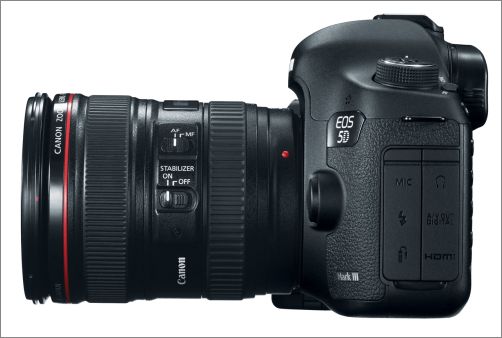
The EOS 5D MkIII is also available with the EF24-105/4L IS USM as a kit which can save several hundred dollars over the separate body and lens prices and is certainly worthwhile if you want the 24-105/4L IS USM lens.
Where to Buy
The EOS 5D MkIII is pretty new and so you won't see big discounts from the $3499 "list price" yet. Amazon, Adorama and B&H usually have the best prices of the reliable retail stores. Note that the EOS 5D MkII (also available with the EF 24-105/4L IS USM as a kit) is still a current Canon camera and is also available new at a saving of about $1300-$1400 over the new EOS 5D MkIII.
